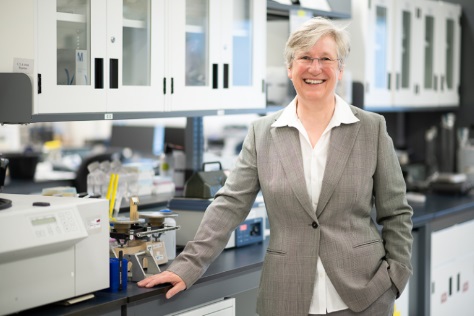By Terri Coles
Memorial University and Western University researchers recently published their discovery of the first gene for a common cause of hearing loss in adults.

Dr. Terry-Lynn Young in the genetics lab at the Faculty of Medicine at Memorial University. // Photo: Rich Blenkinsopp
The study was designed by Nelly Abdelfatah, PhD candidate, Faculty of Medicine, Memorial University; Dr. Terry-Lynn Young, Faculty of Medicine, Memorial University; and Dr. Susan G. Stanton, Western University, and published in Human Genetics.
The researchers identified a causative gene, FOXL1, for autosomnal dominant otosclerosis in an affected extended family in Newfoundland and Labrador. The same mutation was also identified in an otosclerosis case in Ontario.
The research discovery comes through collaborative work between Memorial's Faculty of Medicine and Faculty of Science, as well as clinical collaborators at Western University.
Paving the way
In otosclerosis, bone growth causes the stapes, one of the tiny bones in the middle ear, to become fixed in place. As a result, it can't vibrate and conduct sound waves to the inner ear, resulting in hearing loss.
Otosclerosis is a dominant condition, which means it can be caused when inherited through just one parent instead of both, as in a recessive condition.
This also makes it trickier to chase down genetically, because you are looking for a single gene mutation and not a pair of them.
"This is really the first protein that's been identified that allows you to know the biological function of that gene." Dr. Terri-Lynn Young
Through the use of both traditional gene mapping and newer sequencing methods, however, a large family in Newfoundland and Labrador with otosclerosis was identified.
Then, their DNA was analyzed to see which segment in a sequence was found in those with the condition.
A conservative diagnosis of the disease was necessary in order to hone in on those who definitely had otosclerosis, instead of other forms for hearing loss, says Dr. Young.
"Our colleagues at Western University were key and all this because they helped us develop the recruitment criteria," she said.
Possible prevention
There is no current cure for otosclerosis, but many patients use hearing aids or have surgery to replace the stapes bone with a prothesis.
The surgery does not always work to restore hearing, however, and the condition gets worse over time.
"Having a genetic test means that otosclerosis could be confirmed before their hearing declines significantly." Dr. Sue Stanton
"Discovering a gene responsible for otosclerosis will help us to understand the biology of this bone disease, and will pave the way to finding new drugs and therapies and possibly even prevent otosclerosis," Dr. Stanton said.
The identification of a causative gene for the condition also paves the way for a genetic test, especially for those with otosclerosis in their family, says Dr. Stanton.
"Identifying a causative gene also provides the basis for a new genetic test, especially for those with otosclerosis in their family. Having a genetic test means that otosclerosis could be confirmed in those with a genetic defect, even before their hearing declines significantly, which could be important as new treatments become available."
Further research
Dr. Young expects that co-operation with other Memorial researchers and with those at Western will continue.
Dr. Valerie Booth and her team in the Faculty of Science played a role in looking at the structure of the mutated protein. Drs. Curtis French, Faculty of Medicine, and Ahmed Mostafa, a post-doctoral fellow with Dr. Young, looked at how the gene mutation affected the way the protein misfunctioned in cells.
Research audiologist Anne Griffin at the Centre for Genomics-Based Research and Development in Hearing Science in Grand Falls-Windsor added her expertise.
From left are Anne Griffin, Matthew Lucas, Dr. Sue Stanton and Dr. Terry-Lynn Young.
"I think in terms of basic research, this is really the first protein that's been identified that's involved in the repression of bone remodelling in the inner ear," Dr. Young said.
"That can have a huge impact. And that allows you to know the biological function of that gene and when it might interact with other genes."
Down the road, the research could lead to therapies that target the specific proteins affected or help identify others at risk of developing this type of otosclerosis.
The research team is currently looking for other genes related to otosclerosis in other families, in hopes of mapping them with the same techniques used in this study.
Families with a history of otosclerosis who are interested in participating in future research can reach out to Dr. Young or Ms. Griffin.
"The more families, the better," Dr. Young said.













